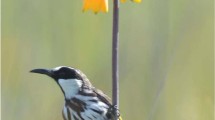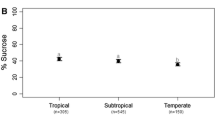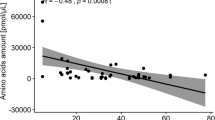Abstract
Although the volume and chemical composition of nectars are known to vary among plant species and to affect pollinator response to plants, relatively little is known of the variation in volume, and sugar and amino acid composition within species. We collected nectar from Impatiens capensis in a nested design: three flowers from each of three plants from each of three populations. This design enabled us to quantify variation within individual plants, among plants within populations, and among populations. Using high performance liquid chromatography, we analyzed the sugar and amino composition of the 27 flowers. Analysis of variance showed that none of the parameters (volume, concentrations of three sugars and 24 amino compounds) varied within individuals. Variation in nectar volume was not significant among plants but was nearly significant among populations. Of the three sugars detected (sucrose, glucose, and fructose), the only significant variation was that of sucrose among populations. Concentrations of 12 amino compounds varied significantly at the plant level while 7 amino compounds varied among populations. The results indicate that: (1) pooling of nectar samples from flowers of individual plants can be an acceptable methodology for those seeking to understand within species variation; (2) amino compounds appear to vary more than either volumes or sugar concentrations; (3) future studies should assess how much of the observed variation is due to genetic versus environmental differences; (4) additional studies should examine the geographic variation in nectar parameters and pollinators of I. capensis in order to assess the role different pollinators play in shaping nectar composition.
Similar content being viewed by others
References
Argyres AZ, Schmitt J (1991) Microgeographic genetic structure of morphological and life history traits in a natural population of Impatiens capensis. Evolution 45: 178–189
Baker HG, Baker I (1977) Intraspecific constancy of floral nectar amino acid complements. Bot Gaz 138: 183–191
Baker HG, Baker I (1983a) A brief historical review of the chemistry of floral nectar. In: Bentley B, Elias T (eds) The biology of nectaries. Columbia University Press, New York, pp 126–152
Baker HG, Baker I (1983b) Floral nectar sugar constituents in relation to pollinator type. In: Jones CE, Little RJ (eds) Handbook of experimental pollination biology. Scientific and Academic Editions, New York, pp 117–141
Baker HG, Baker I (1986) The occurrence and significance of amino acids in floral nectar. Plant Syst Evol 151: 175–186
Bertin RI (1989) Pollination biology. In: Abrahamson WG (ed) Plant-animal interactions. McGraw-Hill, New York, pp 23–86
Campbell DR, Waser NM, Price MV, Lynch EA, Mitchell RJ (1991) Components of phenotypic selection: pollen exports and flower corolla width in Ipomopsis aggregata. Evolution 45: 1458–1467
Cruden RW, Hermann SM, Peterson S (1983) Patterns of nectar production and plant-pollinator coevolution. In: Bentley B, Elias T (eds) The biology of nectaries. Columbia University Press, New York, pp 80–126
Devlin B, Horton JB, Stephenson AG (1987) Patterns of nectar production of Lobelia cardinalis. Am Midl Nat 117: 289–295
Faegri K, Pijl L van der (1979) The principles of pollination ecology, 3rd edn. Pergamon Press, New York
Freeman CE, Wilken DH (1987) Variation in nectar sugar composition at the intraplant level in Ipomopsis longiflora (Polemoniaceae). Am J Bot 74:1681–1689
Freeman CE, Reid WH, Worthington RD (1985) Patterns of floral nectar-sugar composition of Ipomopsis longiflora (Polemoniaceae) near the contact zone of its subspecies longiflora and australis. Am J Bot 72: 1662–1667
Galen C, Plowright RC (1985) The effects of nectar level and flower development on pollen carry-over in inflorescences of fireweed (Epilobium angustifolium) (Onagraceae). Can J Bot 63: 488–491
Gilliam M, McCaughey WF, Moffett JO (1981) Amino acids in the floral nectar of cotton. Apidologie 12: 125–132
Gottsberger G, Arnold T, Linskens HF (1989) Intraspecific variation in the amino acid content of floral nectar. Bot Acta 102: 141–144
Grünfeld E, Vincent C, Bagnara D (1989) High-performance liquid chromatography analysis of nectar and pollen of strawberry flowers. J Agric Food Chem 37: 290–294
Heinrich B (1972) Energetics of temperature regulation and foraging in a bumblebee, Bombus terricola Kirby. J Comp Phys 77: 49–64
Heinrich B (1975) Energetics of pollination. Annu Rev Ecol Syst 6: 139–170
Heinrich B, Raven PH (1972) Energetics and pollination ecology. Science 176: 597–602
Hodges SA (1993) Consistent interplant variation in nectar characteristics of Mirabilis multiflora. Ecology 74: 542–548
Knight SE, Waller DM (1987) Genetic consequences of outcrossing in the cleistogramous annual, Impatiens capensis. I. Population-genetic structure. Evolution 41: 969–978
Marden JH (1984) Intrapopulation variation in nectar secretion in Impatiens capensis. Oecologia 63: 418–422
Murrell DC, Shuel RW, Tomes DT (1982) Nectar production and floral characteristics in birdsfoot trefoil (Lotus corniculatus L.). Can J Plant Sci 62: 361–371
O'Reilly E, Lanza J (1995) Fluorescamine: a rapid and inexpensive method for measuring total amino acid concentrations in plant nectars. Ecology, in press
Pleasants JM, Chaplin SJ (1983) Nectar production rates of Asclepias quadrifolia: causes and consequences of individual variation. Oecologia 59: 232–238
Real LA, Rathcke BJ (1991) Individual variation in nectar production and its effect on fitness in Kalmia latifolia. Ecology 72: 149–155
Rice WR (1989) Analyzing tables of statistical tests. Evolution 43: 223–225
Robinson DG, Andreae M, Sauer A (1985) Hydroxyproline-rich glycoprotein biosynthesis: a comparison with that of collagen. In: Brett CT, Hillman JR (eds) Biochemistry of plant cell walls. Society for Experimental Biology, seminar series 28. Cambridge University Press, New York, pp 155–176
Rust RW (1977) Pollination in Impatiens capensis and Impatiens pallida (Balsaminaceae). Bull Torrey Bot Club 104: 361–367
Schemske DW (1978) Evolution of reproductive characteristics in Impatiens (Balsaminaceae): the significance of cleistogramy and chasmogamy. Ecology 59: 596–613
Schmitt J, Gamble SE (1990) The effect of distance from the parental site on offspring performance and inbreeding depression in Impatiens capensis: a test of the local adaptation hypothesis Evolution 44: 2022–2030
Smith LL, Lanza J Smith GC (1990) Amino acid concentrations in extrafloral nectar of Impatiens sultani increase after simulated herbivory. Ecology 71: 107–115
Thomson JD (1986) Pollen transport and deposition by bumble bees in Erythronium: influences of floral nectar and bee grooming. J Ecol 74: 329–341
Waller DM (1982) Jewelweed's sexual skills. Nat hist 91: 32–38
Wunnachit W, Jenner CF, Sedgley M (1992) Floral and extrafloral nectar production in Anacardium occidentale L. (Anacardiaceae): an andromonoecious species. Int J Plant Sci 153: 413–420
Zar JH (1984) Biostatistical analysis. 2nd edn Prentice-Hall, Englewood Cliffs, NJ
Zimmerman M, Cook S (1985) Pollinator foraging, experimental nectar-robbing and plant fitness in Impatiens capensis. Am Midl Nat 113: 84–91
Author information
Authors and Affiliations
Rights and permissions
About this article
Cite this article
Lanza, J., Smith, G.C., Sack, S. et al. Variation in nectar volume and composition of Impatiens capensis at the individual, plant, and population levels. Oecologia 102, 113–119 (1995). https://doi.org/10.1007/BF00333318
Received:
Accepted:
Issue Date:
DOI: https://doi.org/10.1007/BF00333318




